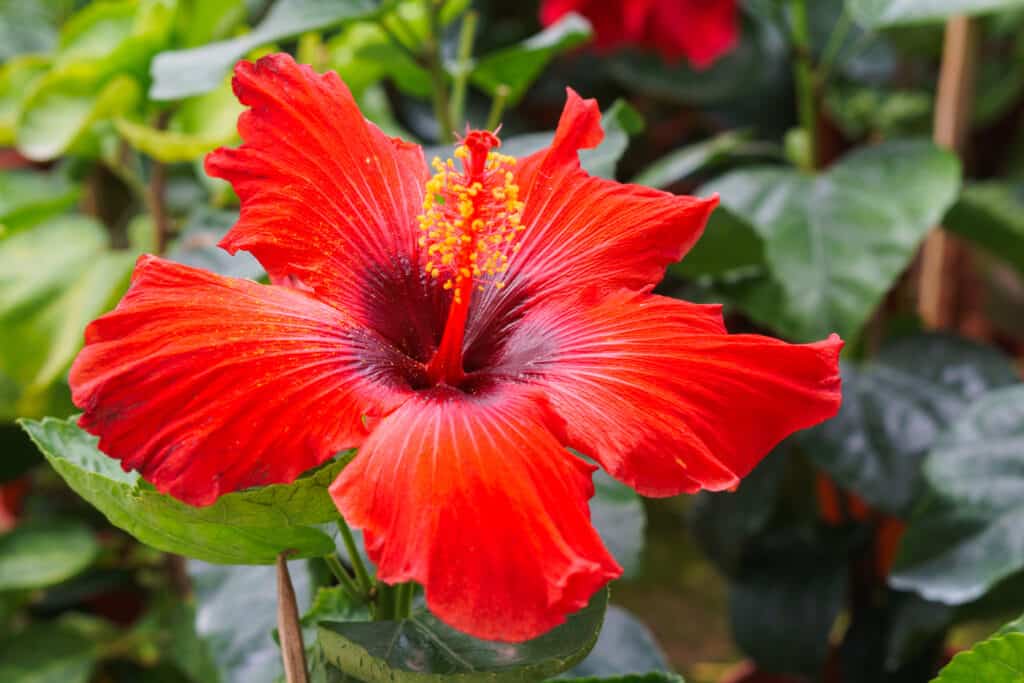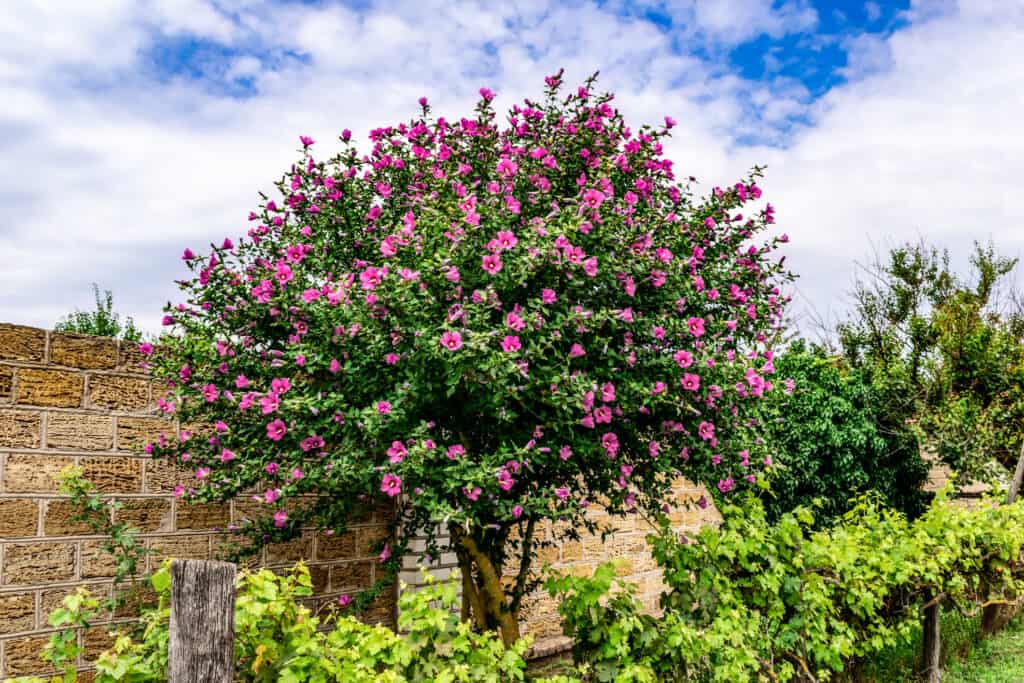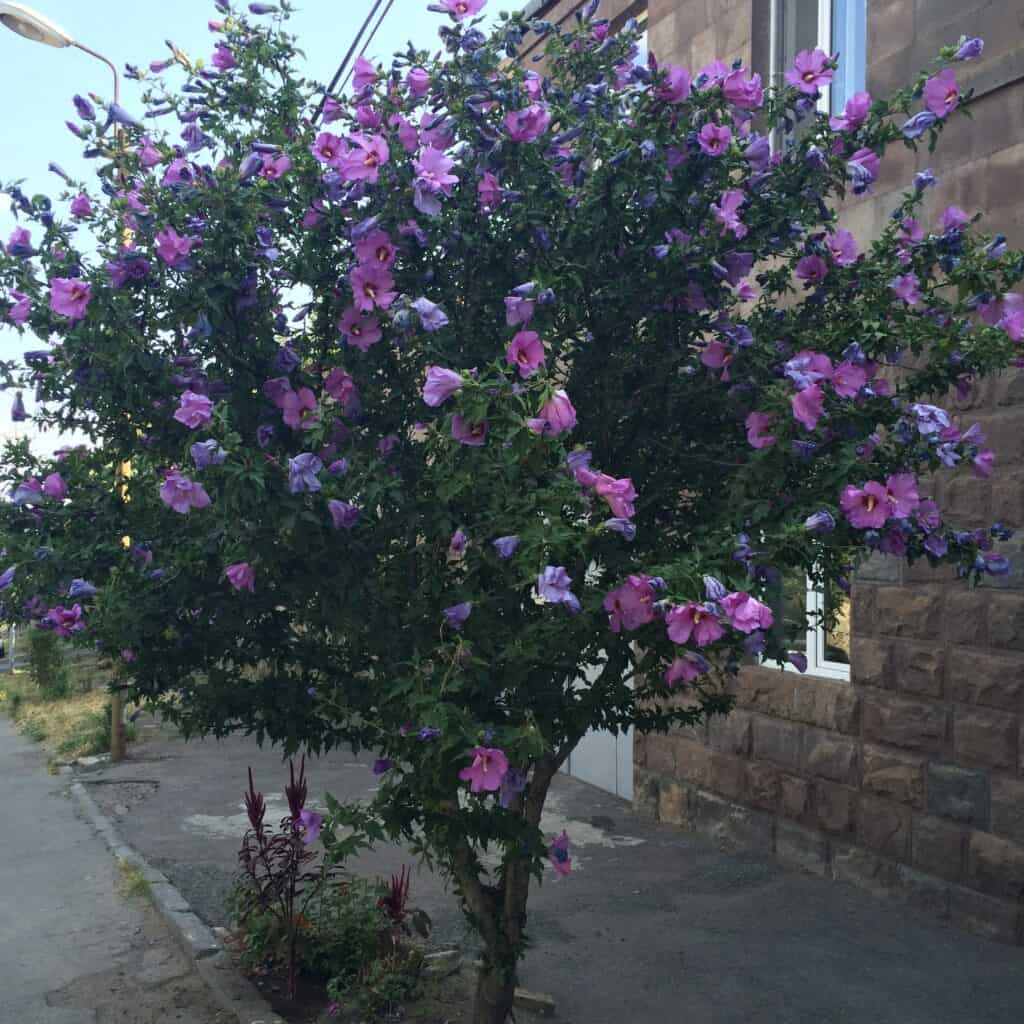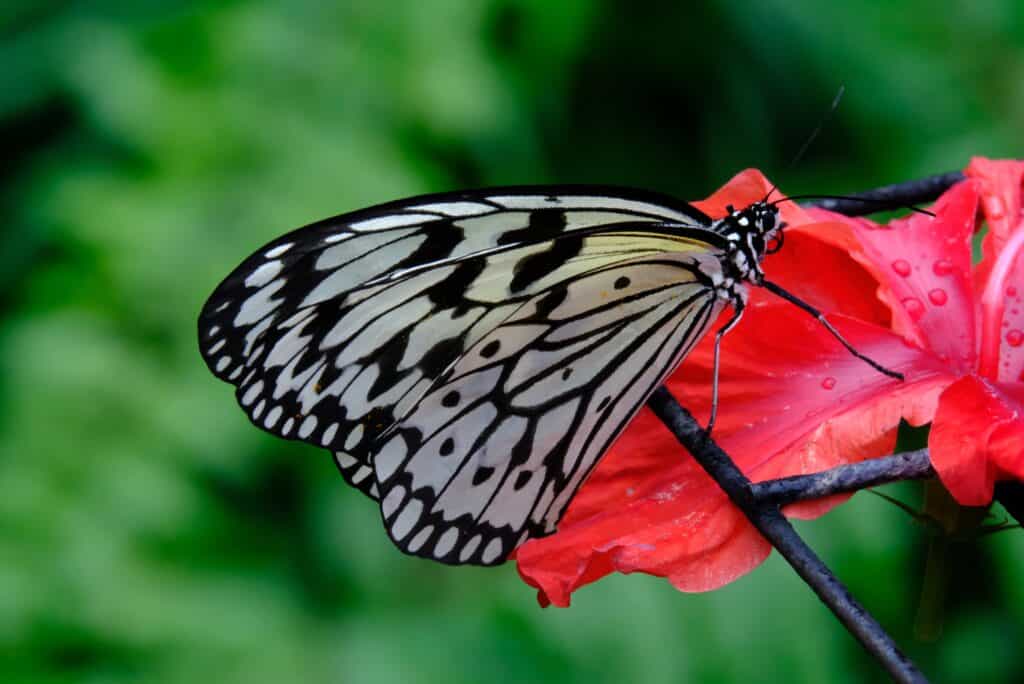The flowers of the tropical hibiscus plant are known for their trumpet shape and bright colors – including vibrant pink, orange, yellow, and red. You may also recognize the taste of hibiscus as a popular flavor for candy, tea, and other desserts and beverages. This plant produces flowers, leaves, and seeds, all edible for humans. The vibrant hibiscus flowers can make a tasty floral juice that brings up memories of an island vacation.
In addition to producing delicious drinks and food, hibiscus plants are a favorite of landscapers in warmer climates because of their beautiful flowers. However, you may sometimes find hibiscus flowers growing on small trees. At other times, they seem to grow on shrubs. Is there a difference between the two plants? If so, how can you distinguish a hibiscus bush from a hibiscus tree?
This article discusses hibiscus bushes and hibiscus trees. By the end, you can identify the distinctive hibiscus flowers. We will also review some common misconceptions about what separates a hibiscus “bush” from a hibiscus “tree.”
We will begin by asking two questions. First, what is the difference between a hibiscus bush and a hibiscus tree? Second, how can you tell the two apart? Let’s answer these questions together now!
Hibiscus Bush vs. Hibiscus Tree: Differences
Our first question is, “What differentiates a hibiscus bush from a hibiscus tree?” The short answer is that these two plants are not fundamentally different! Hibiscus is a genus of flowering plants which includes more than 200 different species. Hibiscus is a genus in the mallow, or Malvaceae, family. Malvaceae has more than 240 genera, encompassing thousands of herbaceous plants, shrubs, and trees. Many include flowering plants that blossom with vibrant, noticeable five-petaled flowers.

is a genus that includes more than 200 species, many blossom with vibrant five-petaled flowers.
©MajestiX B/Shutterstock.com
Common Hibiscus Species in North America
The Hibiscus genus encompasses several species which blossom with large, colorful flowers. These species are often called hibiscus or sometimes known as Rose of Sharon or Rose Mallow. Some of the most common species in the genus are Hibiscus syriacus and Hibiscus rosa-sinensis. Hibiscus syriacus, often called the Rose of Sharon and known as a common hibiscus in North America, is one of the most popular in the United States. Hibiscus rosa-sinensis often goes by Chinese hibiscus, Hawaiian hibiscus, and rose mallow. However, it is also sometimes known as a common hibiscus, particularly in northern parts of the United States, where it is more resilient to colder temperatures. Both of these species come in many different varieties. The various Hibiscus syriacus and Hibiscus rosa-sinensis cultivars often feature flowers of different sizes and colors or have other unique features.
Hibiscus moscheutos and Hibiscus mutabilis are other species native to the United States and are sometimes also grown into the shape of a tree. However, all four of these species of hibiscus naturally grow in the shape of a bush. Hibiscus bushes and trees are not different species or even different cultivars. Rather, growers can achieve a tree-like shape in their hibiscus plants by pruning and training. This process may change the naturally bushy hibiscus plants into a single-stalked tree-like shape.

can be pruned into the shape of a tree.
©iStock.com/ioanna_alexa
A Popular Species in North America
Because Hibiscus syriacus is one of the species most commonly grown and frequently sold as a tree in North America, this article will focus on the specifics of growing this common hibiscus. Some of the popular varieties of Hibiscus syriacus are:
- ‘DS03RS’ (Raspberry Smoothie): Bright pink, double-petaled variety.
- ‘Aphrodite’: Variety with delicate pink flowers.
- Blue Chiffon®: Variety with pale purple, semi-double-petaled, 4-inch flowers.
- Blue Satin®: Variety with deep blue petals on the outside, which fade in color toward the eye before becoming bright magenta, contrasted with a yellow stamen.
- Lil’ Kim®: Dwarf variety with 3-inch white flowers, a dark magenta eye, and a yellow stamen.
- ‘Lucy’: Variety with rosy, pink, double-petaled, 4-inch flowers.
Let’s discuss how your hibiscus plant may appear differently if you grow it as a bush or tree.
Hibiscus Quick Facts
| Characteristic | Hibiscus |
|---|---|
| Scientific Name | Hibiscus syriacus |
| Family | Malvaceae |
| Common Name(s) | hibiscus, rose of Sharon, common hibiscus, shrub althea |
| Type of Plant | Hibiscus syriacus, or simply hibiscus, is a deciduous shrub known for blooming in the summer with large, colorful, 5-petaled flowers that can grow to be 3 or 4 inches across and which have a prominent stamen at the center. Hibiscus are bushy shrubs which grow upright, and so may be pruned to be the shape of a small tree. They grow to be between 8 and 12 feet tall and have 4-inch green leaves. |
| Origin | Asia (particularly China) |
| Flowering bush, which may be pruned into a tree shape | 5-8, sometimes 9 |
| Description | Hibiscus syriacus, or simply hibiscus, is a deciduous shrub known for blooming in the summer with large, colorful, 5-petaled flowers that can grow to be 3 or 4 inches across and which have a prominent stamen at the center. Hibiscus are bushy shrubs that grow upright and so may be pruned to be the shape of a small tree. They grow to be between 8 and 12 feet tall and have 4-inch green leaves. |
Description of Hibiscus Shrub
When grown as an upright shrub, Hibiscus syriacus can reach 8 to 12 feet tall, with multiple trunks and bark that is light brown. The bush’s leaves will grow to be 4 inches long and are bright green. In bush form, hibiscus shrubs reach a spread of 6 to 10 feet across at full maturity.
In the United States, hibiscus bushes grow well in USDA Hardiness Zones 5 – 8, sometimes 9. They are generally easy to grow in states of medium moisture and well-drained soil in places of full sun to partial shade. Hibiscus shrubs tolerate heat and humidity and prefer moist soils but can tolerate drought.
Of course, the most noticeable part of the hibiscus bush is its large, dramatic flower blossoms. The hibiscus plant’s trumpet-shaped flowers can grow in various bright colors and range in size with different varieties. They open during mid-summer, usually around June or July. From there, they bloom in shades of red, blue, pink, white, and other shades until the fall. Generally, they grow to be 2 to 4 inches across and open during the day, closing at night.

The most noticeable part of the hibiscus bush is its large, dramatic flower blossoms.
©iStock.com/peterspiro
Description of Hibiscus Tree
When grown as a tree, Hibiscus syriacus shares many of the same qualities as its bush counterpart. It will still grow to reach heights of 8 to 12 feet tall, with leaves that grow to be 4 inches long and flowers that are 2 to 4 inches across. It will also grow in USDA Hardiness Zones 5 – 8 and share similar moisture, soil, and sun needs. However, rather than reaching a spread of 6 to 10 feet across, as in its shrub form, the tree form is pruned to have a single trunk.
If a hibiscus plant is healthy and hardy at about 12 months old, growers may begin training it into a tree shape. When it matures, the hibiscus tree will have a single trunk (or just a few stems if a multi-trunked tree shape) and several feet of trunk clearance from the ground before the foliage begins.
Hibiscus Bush vs. Hibiscus Tree: Key Differences
As described above, the significant differences between a hibiscus shrub and a hibiscus tree come from training and pruning, not from breeding or biology. Those looking to purchase and plant a hibiscus tree do not need a different species or variety but can choose a cultivar of Hibiscus syriacus whether they want a tree or a bush. Without intentional training, a hibiscus bush will naturally develop into a shrub in height and width. In this form, it will have many trunks, producing multiple branches and full foliage up to 8 or 10 feet across.
Now, let’s learn more about hibiscus plants and how to grow the bush or tree of your dreams!
Hibiscus Bush vs. Hibiscus Tree: History
Today, there are numerous hibiscus species which grow across the world. However, these modern hibiscus plants are descended from just eight original species.
Hibiscus syriacus was first cultivated in East Asia. The plant is native to Korea and parts of China but was brought to other regions of Asia, where it grew in popularity. The scientific name arose after the species was initially gathered from where it grew in Syrian gardens, even though historians now agree that this was not its place of origin. Today, Hibiscus syriacus and other hibiscus species are cultivated widely. They thrive particularly well in tropical and subtropical climates, where extended periods of sun contribute to especially large and beautiful flowers.
Today, hibiscus plants are incredibly popular flowering shrubs prized for their large, bright flowers that come in various colors and even have different color patterns. However, you may also notice that you can buy many Hibiscus syriacus varieties in tree form. Selling a variety as a small tree sets it apart from the bushes, but the tree form is not a distinctive cultivar quality. Rather, it is the result of early pruning. When a young hibiscus plant is trained in the nursery, plant growers prune away the branches to shape them into a single, central trunk or braid or weave multiple trunks together.

can be trained through pruning to grow as a tree. It would be best to start pruning when the plant is about 12 months old.
©Pandukht, CC BY-SA 4.0 <https://creativecommons.org/licenses/by-sa/4.0>, via Wikimedia Commons – License
Hibiscus Bush vs. Tree: Cultivation
The biggest difference that separates a hibiscus bush from a tree is that growing it into a tree shape takes work. Naturally, hibiscus plants are bushy and grow many trunks and branches which extend outward. Because pruning it into a tree shape contradicts its natural growth pattern, growing a hibiscus plant into a tree requires regular pruning and training from early on. Starting when the plant is only a year old, a grower will begin to prune away other branches and, if needed, reinforce a single trunk so that it can grow straight up. This makes growing a hibiscus tree more labor-intensive for the nursery and a plant that will require more care when planted in a yard or container at home.
Some experts recommend pruning your hibiscus plant each winter or spring to the point where the bottom third of the shrub is bare, leaving only the main stem. You can work on developing your tree’s canopy by removing branches growing cross-ways or downward. Each year, you must repeat this process until you achieve your desired height for the tree. You will also want to identify several strong branches growing upward in the desired direction. Take off any side growth and prune the branches so that there is an open canopy for new growth.
When planted outdoors, the hibiscus plant will attract wildlife, such as butterflies and hummingbirds, who will seek nectar from the flowers.

Hibiscus flowers attract butterflies and hummingbirds looking for nectar.
©Adny/Shutterstock.com
Hibiscus Bush vs. Tree: Growing Conditions
You will find that Hibiscus syriacus grows well in USDA Hardiness Zones 5-8, sometimes in Zone 9. Ensure the plant has adequately nutritious soil, partial to full sun to promote larger flowers, and warm temperatures to blossom.
Pests
Hibiscus plants are fairly pest-free. However, they can be susceptible to leaf spots, blights, rusts, canker, and insects such as Japanese beetles, which can damage the leaves if not managed appropriately.
Maintenance
Your hibiscus shrub will flower annually with very little maintenance. Pruning it into your ideal shape each spring will allow you to control its size and growth. Some experts suggest pruning back to only a few buds at the end of the winter will lead to larger blooms later in the year. In comparison, your hibiscus tree will also flower year after year. However, maintaining its tree-like shape will require your attention. In addition to the standard pruning required in the spring, keeping the tree shape will require continuous shaping and training.
A benefit to growing a hibiscus tree, rather than leaving it as a shrub, is that it allows you to grow your hibiscus as a houseplant during the colder months. Plant your hibiscus in a large pot near a bright window. Your indoor hibiscus plant will survive as long as it can grow in a sunny location. Place it back outside during the spring or summer, where it can get fresh air and adequate direct sunlight. Ensure you repot in larger pots as your tree grows and maintain your standard pruning. Experts do not recommend to keep your hibiscus plant indoors year-round. Hibiscus plants are outdoor plants that require sunlight and outside air to thrive. However, if your climate reaches very cold temperatures, bringing your hibiscus tree indoors in the winter can be a way to keep it healthy and happy.

You can plant your hibiscus in a large pot to be brought indoors during cold temperatures.
©Jon Kraft/Shutterstock.com
Hibiscus Bush vs. Hibiscus Tree: Considerations
Some considerations you may want to keep in mind when determining if you prefer to plant and grow a hibiscus bush or if you want to transform it into a small tree:
- Which species and variety do you want to choose, and is it one suitable for pruning into a tree?
- What time will you devote to plant maintenance and upkeep (including regular pruning)?
- What money will you spend to purchase a mature tree instead of a young shrub, considering that mature trees may be more expensive?
- Are you hoping to plant your hibiscus outdoors or grow it inside a container indoors?
- Do you live in a climate suitable for growing your chosen species and variety outside?
How you answer these questions may guide you to the best species and variety for you, and help you decide whether to grow your hibiscus plant as a shrub or a tree.
Are Hibiscus Trees or Bushes Harmful to Pets?

The Hibiscus syriacus is the only hibiscus that may be harmful to pets.
©Heinsdorff Jularlak/Shutterstock.com
Most varieties of hibiscus trees and bushes are not harmful to pets. One particular variety does not have a clear consensus on its toxicity, but there is evidence to suggest it is potentially toxic to pets.
The Rose of Sharon hibiscus has documentation to suggest it can be harmful to pets, particularly cats, according to the Charlotte Humane Society. Symptoms that a pet who has consumed this plant could exhibit are appetite loss, vomiting, and diarrhea.
The root of the Rose of Sharon hibiscus is highly toxic, capable of causing more serious symptoms like gagging or coughing, corneal discomfort or pain, stinging or burning in the mouth or throat, swelling or blistering of the mouth or tongue, or discomfort swallowing.
In Summary
This article reviews two strategies for growing hibiscus plants. You may even choose a variety with edible flowers, which you can transform into tea or baked goods. Whether you grow a hibiscus tree or shrub may depend on your landscaping goals, the amount of space you have available, and which species or variety of hibiscus you choose. Whether you want to achieve a wide, natural shrub form, or train your plant into the shape of a small tree, hibiscus plants will bring vibrant color and a tropical look to your yard or garden.
The photo featured at the top of this post is ©
Sources
- Missouri Botanical Garden, Available here: https://www.missouribotanicalgarden.org/PlantFinder/PlantFinderDetails.aspx?kempercode=c522
- Gardening Channel, Available here: https://www.gardeningchannel.com/hibiscus-tree/
- USDA, Available here: https://adminplants.sc.egov.usda.gov/java/profile?symbol=HISY
- North Carolina Extension, Available here: https://plants.ces.ncsu.edu/plants/hibiscus-syriacus/
- Arbor Day Foundation, Available here: https://www.arborday.org/trees/treeguide/treedetail.cfm?itemID=915
- SF Gate, Available here: https://homeguides.sfgate.com/train-rose-sharon-hibiscus-bush-become-single-stem-tree-30052.html
Thank you for reading! Have some feedback for us? Contact the AZ Animals editorial team.






